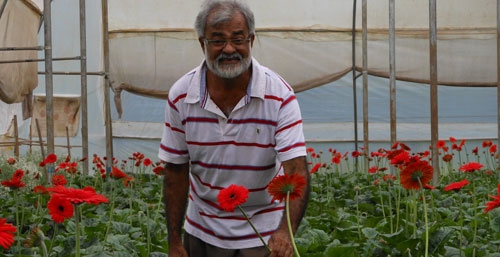Traditional farming may be dying, but the farmer is moving to blooming pastures

At the end of the winding road, surrounded by thick foliageis a polly-house. Spread over 1,040 square meters, the polly-house plays hostto 6,000 Gerbera or African daisy plants. Constant rains have increasedhumidity levels. Pramod Jambhale the owner of the polly-house is worried.Plucking a Gerbera, infected by fungus he said, “Humidity is a killer for thisbusiness.” During the peak season he gets 600 flowers a day and off-season 500flowers.
Traditionally from an agrarian family Pramod Jhambhlue always wanted to enter the sector. Afterretiring as headmaster in April 2011, he pursued his childhood dream ofbecoming a florist. He said, “It was a natural transition. But, I was clear ithad to be away from traditional crops.” Since December, Jhambhlue has produced11,000 flowers of Gerbera. In February his production went up to 14,000 flowers. “The peak season for the blooms is till June,following which there is a slump,” he said.
Each Gerbera is sold at Rs 3.50 by him. The retailer in turnsells it for Rs 10 to Rs 15 a flower. Explaining this skewed costing Jhambhluesaid, “Gerbera is a highly perishable item. After plucking, it should reach theconsumer in two to three days. Failure to do so is risky for the business. Inorder to off- set the loss, pricing is low.” On an average Goa imports 10,000to 15,000 flowers per day from Pune and Satara. This is a problem for Goan farmers as these flowers are priced at Rs 2each. “This is killing the local Gerberamarket,” said Jhambhlue. He is planningopening exclusive Gerbera outlets along with other farmers. “Hopefully willchange the skewed pricing,” he said.
Profit in this business is about Rs 25,000 to Rs 30,000 permonth. “This is not high due to labour cost and procurement of fertilisers andpesticides from other states,” he said.
Ask him what should the government, do if these projects needto be viable. “The government should encourage florists to buy from localfarmers. Once the buying from outside reduces the output will increase,” hesaid.
Mining dust is another problem. Even after consistent rains,the mud settled on the polly-house has not washed off. With reduced sunlight,the growth of the plants is affected. He signs off, “Though not easy, Gerberafarming is a good business.”